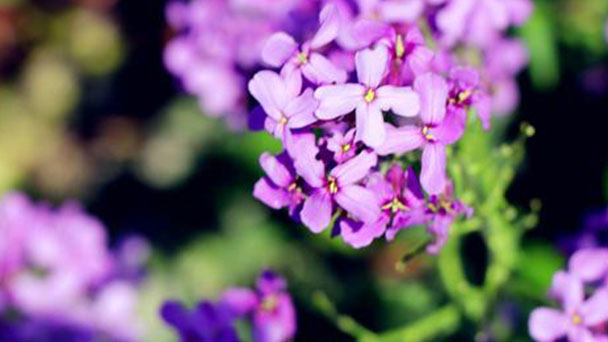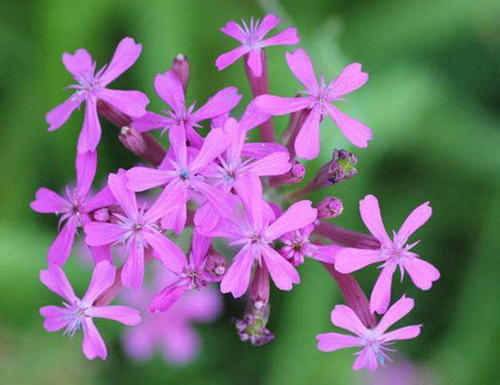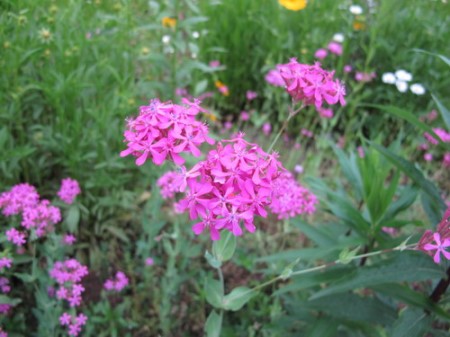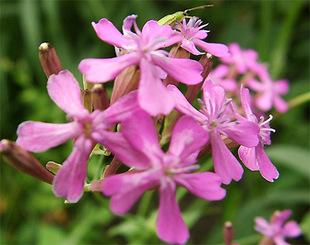Sweet William catchfly (Silene armeria) profile
Written by Maggie
Mar 17 2021

Sweet William Catchfly (Silene armeria) is an annual herb of the genus Silene in the family Dianthus. Sweet William catchfly is usually pink and green in height. Stems are solitary, erect, distally branched, glabrous or sparsely pubescent, distally mucinous.
Sweet William catchfly picture

Sweet William catchfly info
| Botanical Name | Silene armeria |
| Common Names | Sweet William catchfly |
| Plant Type | Herbaceous perennial |
| Sun | Full sun to part shade |
| Hardiness Zones | 5 to 8 |
| Flower color | Rose pink |
| Native Area | Central and southern Europe |
| Mature size | 1.00 to 1.50 feet high, 0.50 to 0.75 feet wide |
Morphological characteristics of Sweet William Catchfly
Sweet William Catchfly is an annual plant, 30-50 cm tall, often pink green. Stems are solitary, erect, distally branched, glabrous or sparsely pubescent, distally mucinous.Basal leaves spatulate, flowering withering; Cauline leaves are ovate-cordate to lanceolate, 2.5 -- 7 cm long and 7 -- 35 mm wide, basally semicirculate, apically acute or obtuse, glabrous on both surfaces.
The inflorescences of Sweet William Catchfly were more compact. Pedicels are 5 -- 10 mm long, glabrous; Bracts are lanceolate, membranous, 3-5 (-7) mm long, glabrous; Calyx is cylindric, 12-15 mm long, ca. 2 mm in diam., purplish, glabrous, longitudinal veins purplish, calyx teeth short, broadly triangular-ovate, tip obtuse, margin membranous; Pistil stalks are glabrous, ca. 5 mm long; Petals of sweet william catchfly are reddish, claws oblanceolate, calyx not exposed, glabrous, auricles inconspicuous, segments obovate, emarginate or entire; Corolla segments are lanceolate, ca. 3 mm; Stamens are slightly exerted; Style is slightly exerted. Capsule of Sweet William catchfly is oblong, 6-7 mm long, shorter than persistent calyx; Seeds are round, reiform, ca. 0.5 mm long, reddish-brown.
Sweet William Catchfly is a high-growth plant with dense clusters of flowers in pink, white and light red. The flower stems secrete special mucus under nodes, and insects are stuck to each other. Therefore, it is also known as an "insect catching plant".
Sweet William Catchfly flowers from May to June and fruit from June to July.
Ecological habits of Sweet William catchfly
Sweet William Catchfly likes warm and full light, full and half sun is ideal, poor fertility in shade. Sweet William catchfly has cold and drought resistance, like loose, well-drained loam, like sunshine and warm and avoids high temperature and humidity, suitable temperature for growth of about 15 ~ 25℃.
How to grow and care for Sweet William catchfly
Humidity
Sweet William catchfly like higher air humidity, air humidity is too low, will accelerate the single flower wither.Also afraid of rain, need to keep the leaves dry at night. The optimum air relative humidity is 65 ~ 75%.
Temperature
Sweet William catchfly like warm climate, avoid hot, in summer when the temperature is higher than 34 ℃ obviously poor growth; Sweet William catchfly is not frost resistant and enters dormancy or dies when the temperature is below 4 ℃ in winter. The optimum growth temperature is 15 ~ 25℃. It is generally planted in autumn and winter to avoid high summer temperatures.
Light
Spring, summer and autumn need plenty of sunshine. When the temperature is higher (the daytime temperature is above 25 ℃), if it is placed in direct sunlight for maintenance, the leaf will become significantly smaller, the internode of the branches will be shortened, the foot leaves will turn yellow, fall off, and the growth will be very slow or enter a semi-dormant state. After the flowering period is maintained indoors for a period of time (10 ~ 15 days), it is necessary to move Sweet William catchfly outdoors to a place with shade (heat preservation) conditions for a period of time (about a month), so alternately, in order to help the plant to accumulate nutrients and continue to bloom.
Water
Like other grass flowers, Sweet William catchfly requires more fertilizer and water, but it requires to follow the fertilization (water) principle of "frequent application of light fertilizer, less times and more, and complete nutrition". After fertilization, it is necessary to keep the leaves and flowers dry at night, and the fertilizer and water management is in the order of "Huabao" -- clear water -- clear water -- "Huabao" -- clear water -- clear water.
Age season
These two seasons are Sweet William catchfly peak growth season, fertilizer and water management interval period is about: 1 ~ 4 days of outdoor maintenance, the interval period is shorter during sunny days or high temperature, the interval period is longer during cloudy and rainy days or low temperature or no watering; Put in the indoor maintenance of 2 ~ 6 days, sunny days or high temperature period between a shorter period, rainy days or low temperature period between a longer period or not pouring.
In the summer
Sweet William catchfly often enters dormant state in the summer high temperature period, does not require much fertilizer and water, and even must control fertilizer and water. The interval period is about: 3 ~ 5 days of outdoor maintenance, the interval period is shorter during sunny days or high temperature, the interval period is longer during rainy days or low temperature or not poured; Put Sweet William catchfly in the indoor maintenance of 4 ~ 7 days, sunny days or high temperature period between a shorter period, rainy days or low temperature period between a longer period or not pouring. Watering time to try to arrange in the morning when the temperature is low, keep the leaves dry at night.Spray the plants often.
In the winter
During the Sweet William catchfly dormant period in winter, it is mainly to control fertilizer and water. The interval period of fertilizer and water management is about 7-10 days. The interval period is shorter during sunny days or high temperatures, while the interval period is longer during cloudy days or low temperatures or no watering. Watering time as far as possible to arrange in the sunny noon when the temperature is higher.
Pruning
Cut off branches with old and yellow leaves of Sweet William catchfly every two months, as long as the temperature is right, to bloom all year round.
Pick a heart
Picking the heart is usually done twice before flowering to encourage more flowering shoots: after a week or two in the pot, or when the plant is 6 to 10 cm tall and has more than six leaves, remove the top and leave the lower 3 to 4 leaves to encourage branching. 3 to 5 weeks after the first coring, or when the lateral branches are 6 to 8 cm long, a second coring is performed. The top of the lateral branches of Sweet William catchfly is removed, leaving the 4 leaves below the branches. After two rounds of heart picking, the plant type will be more ideal and the number of flowers will be more.

The way Sweet William catchfly propagtes
Sowing propagation
The matrix disinfection
The best way to disinfect the substrate used for sowing is to put it in a wok and heat it up, which will kill any insects and diseases.
Sprouting
Soak the seeds in warm water (about the same temperature as your face wash) for 3 to 10 hours, until the seeds absorb water and swell.For very common seeds that germinate easily, this job can be left out.
Sow
For by hand or other tools hard to clamp the tiny seeds of Sweet William catchfly, can put the toothpick wet with water, at the end of the stick a grain by a grain of the seeds on the surface of the substrate, the substrate 1 cm thick, then the planting flower pot into the water, the depth of the water for the flower pot 1/2 ~ 2/3, the height of the water soak up slowly (the method known as "basin leaching method");
For larger seeds of Sweet William catchfly that can be held by hand or with other tools, place the seeds directly into the substrate and seed them at 3 x 3 cm intervals. After sowing, the substrate was covered with 2 ~ 3 times the thickness of seed seed. After sowing available sprayer, fine pore sprinkle sowing matrix quality wet, when the basin soil is slightly dry and then drenched, still pay attention to the strength of watering can not be too big, so as not to flush up the seeds;
Cutting propagation
Substratum
The nutrient soil that uses cuttage namely or the material such as soil of river sand, mud carbon. Family cuttings limited to the condition is difficult to get the ideal cuttings substrate, it is recommended to use prepared and disinfected cuttings substrate; Medium-coarse river sand is fine, but rinse with clean water several times before use. Sea sand and saline areas of river sand are not used, they are not suitable for the growth of flowers and plants.
Selection of cuttings
The branches used for cutting are called cuttings. Usually combined with heart work, pick down the sturdy, no pests and diseases of the top as cuttings, directly with the top cutting.
Disease control of sweet William catchfly
Sweet William Catchfly common diseases and pests include stem rot, rust, aphids, mealworms and other hazards.
The stem rot was sprayed with 50% methyl tobutzine WP 500 times liquid. Rust with 50% wilting rust Ling WP 2000 times liquid spray.
Aphids and mealworms were sprayed with a spray of 1000 to 1500 times of 10% palladium, or a solution of 3000 times of 1.8% abamectin.
Variety classification of sweet William catchfly
Sweet William Catchfly, Sweet William Catchfly, silene armeria L.Phylum Angiosperms; Class Dicotyledona; Central Sedimentae; Caryophyllaceae. Silene;Sweet William catchfly.
Sweet William catchfly distribution
Sweet William Catchfly is a potted plant originally from southern Europe. It is now widely distributed in southern Europe.
Garden use of Sweet William catchfly
Sweet William Catchfly can be used as a cut flower or flower arrangement, and cultivated for ornamental in urban gardens in China. Sweet William Catchfly is suitable for flower paths, flower borders, rock gardens, ground cover, pot or cut flowers.

Latest Updated
- Benefits of Bugleweed - 7 Science-backed Health Benefits
- Bugleweed Dangers & Side Effects - Is It Poisonous?
- How to Plant Evergreen Trees - What You Should Know
- When to Plant Evergreens - Grow Guide for Evergreen Trees
- 12 Wonderful Evergreen Shrubs for Your Garden
- 12 Popular Evergreen Plants with Pictures for Beginners
- When And How To Prune A Lilac Bush Like a Pro
- How to Grow & Care for Lilac Vine (Hardenbergia Violacea)
- Japanese Lilac Tree (Syringa Reticulata) Care & Propagation Guide
- Shumard Oak Pros and Cons - What to Know
Popular Articles
- Winter maintenance of Antirrhinum Majus
- How to Grow Terminalia Mantaly Tree
- How to Grow and Care for Crossostephium Chinense
- How to grow Antirrhinum Majus in spring
- Peristeria Elata (Dove Orchid) Profile: Info & Care Guide
- Underwatered Snake Plant (Sansevieria Trifasciata) - Signs And How To Fix
- How to Care for Brazilian Jasmine Plant (Mandevilla Sanderi)
- How to Grow & Care for Graptopetalum Purple Delight in Summer
- Rosa Chinensis (China Rose): Plant Growing & Care Tips
- How to Care for Baby Sun Rose (Aptenia Cordifolia)